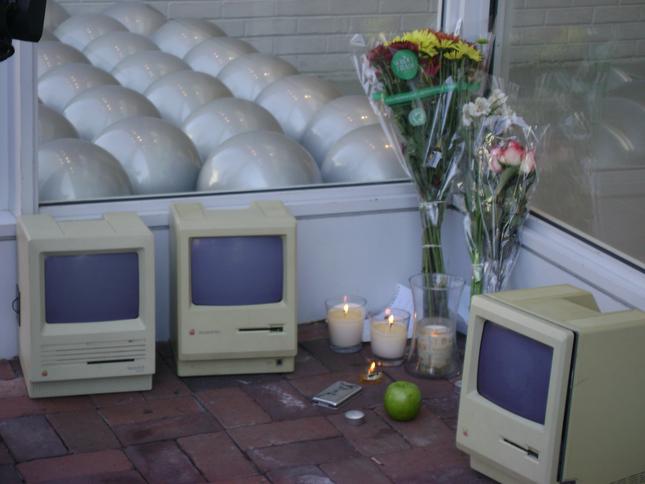Apple Community Mourns the Loss of Steve Jobs
By • November 3, 2011 0 1072

Obituary by Gary Tischler, article by Zachariah Weaver and Kyle Lundberg
If there are a billion iPads in the world, then they all must have lit up Wednesday evening with the news, spread through social media wildfire, that Steve Jobs, the great guru of all things tech, died of pancreatic cancer at the age of 56.
They say that the news was not unexpected. Everyone knew that Steve Jobs, the man of Apple, the man of Pixar, the iFather, was dying for some time now. We knew it was a real possibility three months ago when Jobs, looking gaunt with his rich hair long gone, announced his resignation as CEO of Apple, the company he had co-founded, the company that had fired him, the company he had brought back from economic disaster.
Jobs had been suffering from pancreatic cancer and other diseases for years and yet, during the hardest, most difficult times of his illnesses, he threw out to the world like a painter dashing off masterpieces, the iPhone and the iPad, both revolutionary little computers that contained the world.
Expected or not, his death still came as a shock to the world of Apple, Windows, and Microsoft, which is full of people who had drunk deeply from Job’s vision. They weren’t just users, they were passionate adherents, and in that world, he was not just a rock star; he was Elvis, the Beatles and the Stones rolled into one. The Apple people carried the tools of a new world with a half-eaten logo on them, identifiers like a priest’s white collar. Not since Eve had words with Adam has an apple been so important in the world.
President Barack Obama placed Jobs among “the greatest American innovators—brave enough to think differently, bold enough to believe he could change the world, and talented enough to do it.” Bill Gates, Microsoft cofounder, and Jobs’ chief rival in terms of fame, money and impact, said that “The world rarely sees someone who has had the profound impact Steve has had, the effects of which will be felt for many generations to come.”
The playwright Mike Daisey, an admitted Mac fanatic and author of “The Agony and Ecstasy of Steve Jobs,” a conflicted and critical take on Jobs and his use of China labor, said “I think it is heartbreaking today. I think we’ll never know how much we have lost.”
There was a dark side to Jobs that is historical—the battles within the company, labor issues, his need to control, his fanatic attention to detail, the way some Jobs inventions tended to make previous versions obsolete to the point where they didn’t work. But in the 20th and 21st century, he was a lot like other American inventive geniuses—Edison, for instance, and Henry Ford, and probably Walt Disney, with all three blessed with brilliant marketing skills. They understood the American desire for stuff, for new things, for the shiny as well as the pragmatic and the creative. Jobs, with his creations, made us want things we didn’t know we needed.
But all other things aside, he was an artist and in public, Jobs, who helped create Pixar, something Disney might have been proud of, expressed himself in artistic, philosophic terms. He said he wanted “to marry technology with liberal arts and humanities to make our hearts sing.”
In the end, he had his own impending death covered: “Remembering that you are going to die is the best way I know to avoid the trap of thinking you have something to lose. You are already naked. There is no reason not to follow your heart.”
Yesterday and today, flowers and shrines started popping up at Apple stores all over the country. In a political and economic atmosphere where CEO’s are not the most popular people in America, Jobs got this sign: “We love you Steve.”
Outside the Apple store in Georgetown, the mood is quiet, even reverent. Even the few media types, armed with their cameras and notepads, don’t seem much like talking. They act as if they are attending a funeral. In the corner of the front entrance, to the side of the wide, swinging double doors, lies a humble shrine dedicated to Steve Jobs. Jobs, who died yesterday after a battle with pancreatic cancer, leaves behind a legacy as one of the most influential people in human history.
Jobs almost single-handedly created the modern technological climate that we live in every day. As Fortune Managing Editor Andy Serwer once put it, he was a “once-in-a-century innovator.” Where would this generation be without their iPods, iPhones, and iPads, not to mention the internet? Some people might forget that Jobs’ computer firm, Next, created technology that was used to create the World Wide Web. And one would be remiss in remembering Jobs to forget his hand in the rise of successful computer-animation company Pixar who, under his leadership, was able to grow from a struggling company into an international media powerhouse.
But here, on the streets of Georgetown, the size of the shrine does little to match the stature of the man for whom it is built. Several ancient Macintosh Pro monitors line the makeshift monument, relics from another age, pulled from basements and attics and dusted off; their floppy drives a testament to how quickly the pace of technology marches on. There are a couple of flower bouquets, a few candles and, in the middle of it all, a bright green apple. On the silver back of an old iPod, a fan has written “Steve Jobs: RIP.” Most of the young people walking by the shop stop, just for a few moments, to take a picture of the humble little tribute with their iPhones. More than most people in history, Steve Jobs may have achieved true immortality.
- Photo by Paul Kolnik



